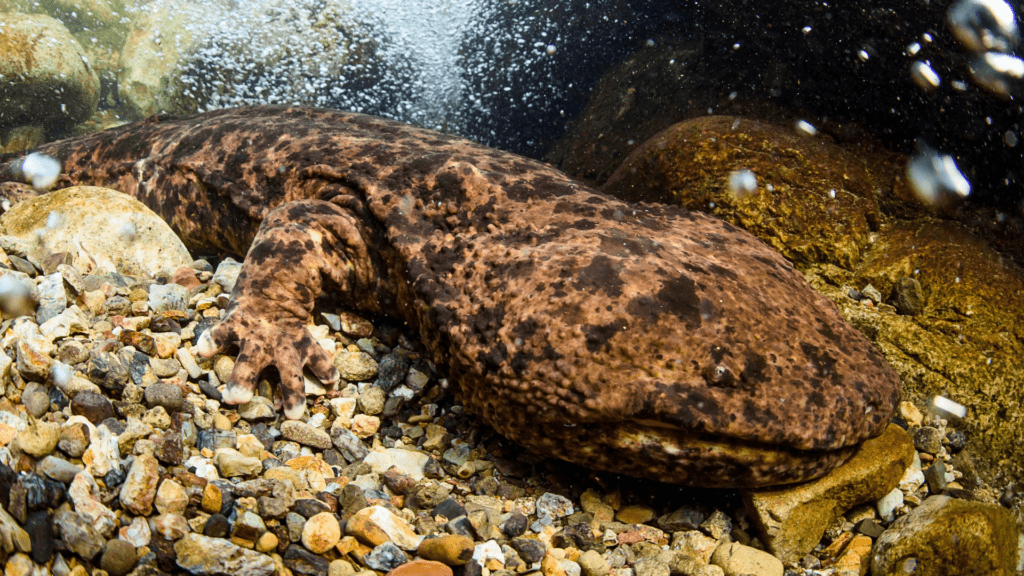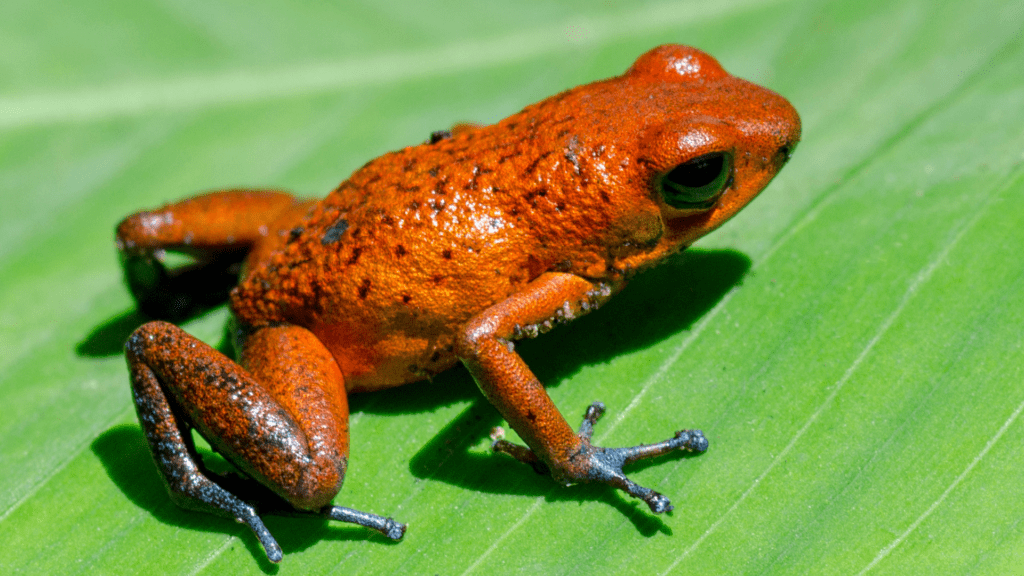Blue Poison Dart Frogs, also known as the Blue Poison Arrow Frog, is a stunning amphibian famous for its vibrant blue coloration and potent poison. This species, scientifically classified as Dendrobates tinctorius “azureus”, is a variant of the dyeing dart frog. Its unique dark spots and striking blue skin make it one of the most recognizable frogs in the world. Discovered in 1969, this frog is native to a few isolated regions in South America and is known as okopipi in the Tirio language.
Scientific Classification
- Kingdom: Animalia
- Phylum: Chordata
- Class: Amphibia
- Order: Anura
- Family: Dendrobatidae
- Genus: Dendrobates
- Species: Dendrobates tinctorius
Physical Description
Size and Weight
Blue Poison Dart Frogs are small amphibians, measuring 1.2-1.8 inches (3.0-4.5 cm) in length and weighing approximately 0.3 ounces (8 grams). Females are slightly larger than males, a characteristic known as sexual dimorphism.
Coloration and Patterns
Blue Poison Dart Frogs are renowned for their bright blue bodies, which serve as warnings to predators. The back and head are a striking sky blue, while the belly and legs are a darker shade. The frog’s body is covered with dark blue and black spots, which are unique to each individual, much like human fingerprints.Habitat and Distribution
Range
Blue Poison Dart Frogs are found in only a few isolated areas, primarily within the rainforests of northern Brazil and the Sipaliwini Savanna of southern Suriname. These frogs thrive in humid, tropical environments where the dense vegetation and abundant moisture create an ideal habitat. They are commonly located near water sources such as streams and ponds, where they can easily find their food, including ants, mites, and other small arthropods. Due to their limited distribution, they are highly specialized to these specific ecosystems, making them vulnerable to habitat loss and environmental changes.
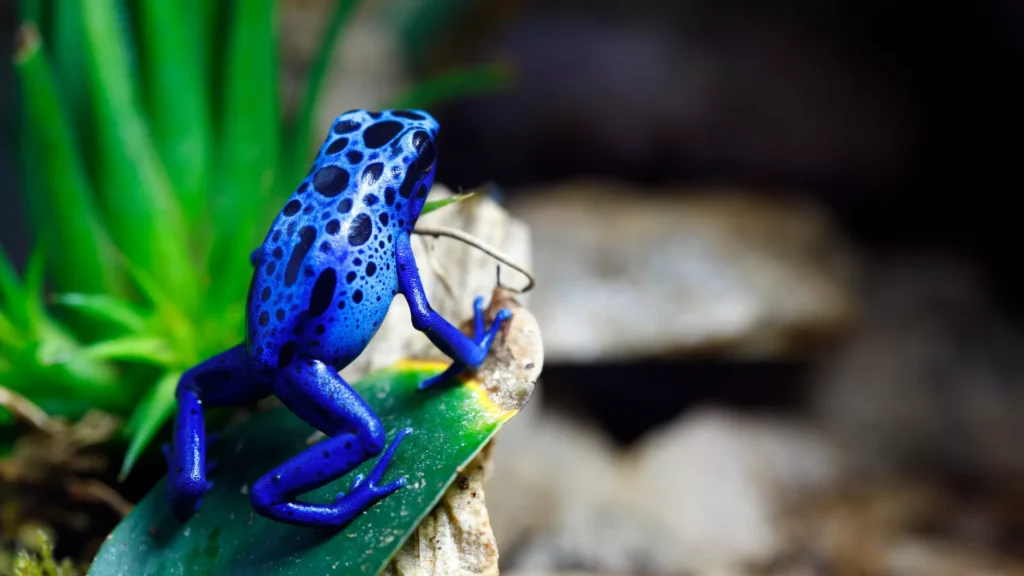
Blue Poison Dart Frogs:Preferred Habitat
Blue Poison Dart Frogs thrive in cool, humid environments with temperatures ranging from 71.6-80.6°F (22-27°C). These frogs are typically found in regions with a combination of dense vegetation and rocky streams, which offer the perfect balance of moisture, shelter, and food sources. The abundant plant life not only provides cover from predators but also plays a crucial role in maintaining the humidity levels that are essential for their survival. The presence of streams ensures a constant supply of water, which is vital for their hydration and breeding. Their preferred habitats are usually located in tropical rainforests or shaded areas, where the conditions remain stable and supportive of their delicate ecosystem needs.

Blue Poison Dart Frogs: Diet and Feeding Habits
Blue Poison Dart Frog is insectivorous, feeding on a variety of small invertebrates. Its diet includes:
- Ants
- Beetles
- Caterpillars
- Flies
- Mites
The toxins in Blue Poison Dart Frog skin are derived from their diet, particularly from consuming certain ants and beetles.
Adaptations
Blue Poison Dart Frogs have developed several adaptations to thrive in their unique habitats. Their bright blue coloration serves as a warning to predators, signaling their toxicity. This is a defense mechanism that helps prevent predation. Additionally, their skin secretes toxic compounds, making them unpalatable to most potential predators. Their small size and agility allow them to navigate dense vegetation and rocky terrains with ease, while their strong, adhesive toe pads help them cling to surfaces, ensuring they can safely move through the forest canopy and avoid dangers on the ground.
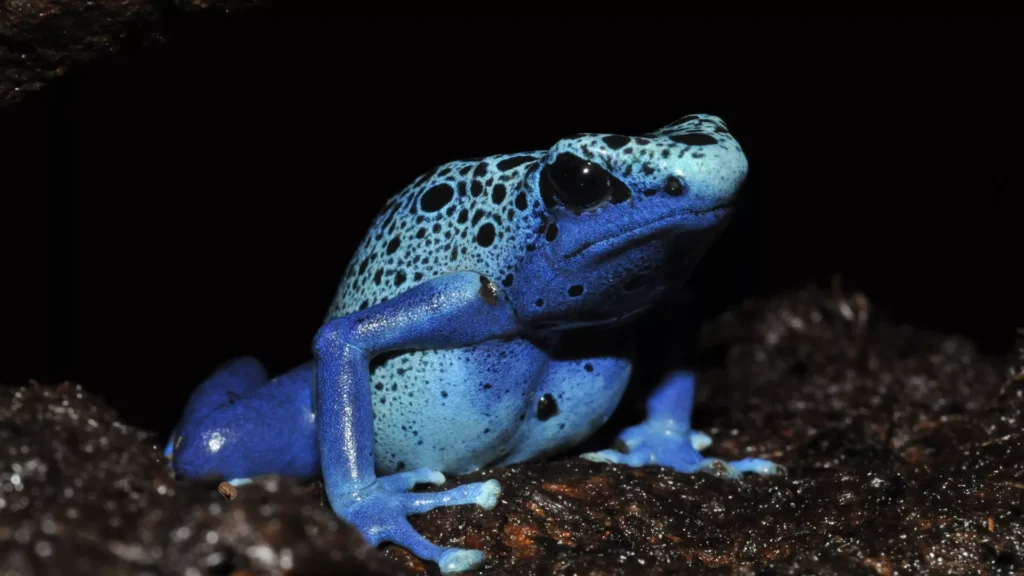
Behavior
Blue Poison Dart Frogs are diurnal, meaning they are active during the day. These frogs exhibit highly territorial behavior, especially during the breeding season, when males aggressively defend their space from other males. Their territoriality is crucial for securing access to prime resources, such as food and mating sites. When threatened, they rely on their toxic skin to deter predators. These frogs also engage in complex courtship rituals, where males call to attract females and demonstrate their strength and suitability as mates. Their behavior is intricately linked to their environmental conditions, emphasizing the importance of maintaining their natural habitat for survival.
Blue Poison Dart Frog: Communication
Blue Poison Dart Frogs communicate through vocal calls and physical displays like chasing and wrestling to establish territory and attract mates. Males produce various calls, including whistles and croaks, to signal their presence and claim their space. These vocalizations are often paired with aggressive behaviors, especially when competing for mates. The physical displays help establish dominance and allow males to show their strength. During mating season, interactions intensify, ensuring that the strongest males secure the best breeding spots. These communication strategies are vital for their social structure and reproductive success.
Blue Poison Dart Frog: Adaptations
Toxic Skin
One of the most significant adaptations of the Blue Poison Dart Frog is its toxic skin. The skin secretes potent toxins, such as batrachotoxins, which are highly effective at paralyzing or even killing predators. This chemical defense makes the frog unpalatable to most creatures, offering it protection from natural threats. The potency of the toxins can vary depending on the frog’s diet, which primarily consists of ants and other small arthropods that contribute to the development of these toxins. This adaptation is crucial in their survival, particularly in the wild, where predators are abundant.
Bright Coloration
The vibrant blue coloration of Blue Poison Dart Frogs serves as an essential warning signal to potential predators. Known as aposematism, this bright color acts as a clear indicator of the frog’s toxicity, warning other animals to avoid attacking it. The striking blue hue makes the frog easily visible in its natural habitat, ensuring that its toxic nature is communicated effectively. This adaptation minimizes the need for the frog to rely on escape mechanisms, as its bright skin is a deterrent in itself, reducing the likelihood of predation.
Sticky Skin
Another remarkable adaptation of the Blue Poison Dart Frog is its sticky skin, which helps it retain moisture in its humid environment. This moisture-retention ability is vital for survival in tropical rainforests, where humidity is high but can fluctuate. Additionally, the sticky nature of their skin aids in the transportation of tadpoles. Adult frogs can carry their young on their backs, where the tadpoles cling to the skin during transport from one water source to another. This unique adaptation not only helps in maintaining moisture but also ensures the survival of the next generation in different water environments.
Blue Poison Dart Frogs: Reproduction and Life Cycle
Mating Behavior
Breeding for Blue Poison Dart Frogs occurs between February and March. During this time, males call from elevated spots to attract females. Their calls vary in intensity, signaling their readiness to breed. When multiple females respond, males compete aggressively for attention. Once a female chooses a mate, she courts him, and the male leads her to a moist area to lay 5-10 eggs. These eggs are placed on damp surfaces, providing ideal conditions for development. The process highlights the importance of vocalization and territory in ensuring the frog’s reproductive success.
Parental Care
The male takes responsibility for the eggs, keeping them moist by urinating on them. After 10-18 days, the tadpoles hatch and are carried to small pools of water, often in tree trunks or bromeliad plants.
Development
Tadpoles undergo metamorphosis over 10-12 weeks, developing lungs and legs. They reach sexual maturity at 10-12 months of age.
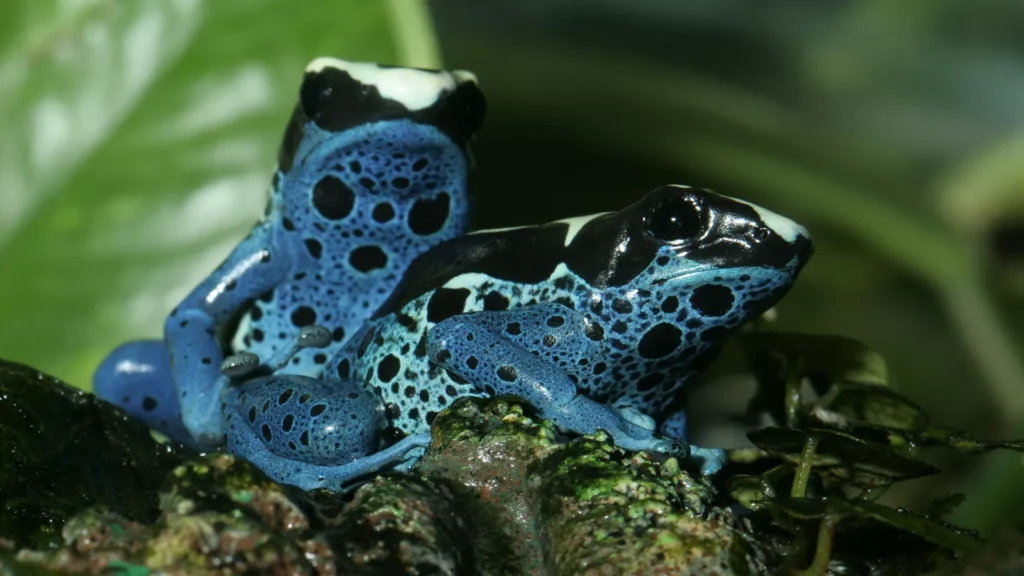
Blue Poison Dart Frogs: Predators and Threats
Natural Predators
Due to their toxic skin, adult Blue Poison Dart Frogs have few natural predators. However, the Northern Redbelly Snake has developed a resistance to their toxins and can prey on them. Tadpoles, which lack toxins, are vulnerable to predators like dragonfly larvae, fish, turtles, and birds.
Blue Poison Dart Frog: Conservation Status
The Blue Poison Dart Frog is classified as Least Concern (LC) by the IUCN, indicating that, at present, the species is not under immediate threat of extinction. However, habitat destruction due to deforestation and the illegal pet trade pose significant risks to their populations. As the frogs’ natural habitats in the rainforests of South America continue to shrink, their numbers may decline. Conservation efforts focused on protecting their habitats and regulating the pet trade are crucial to ensure their long-term survival. Despite their current status, maintaining healthy ecosystems is vital for their continued existence in the wild.
Conservation Efforts
To protect the Blue Poison Dart Frog, conservation efforts focus on:
- Preserving their natural habitats.
- Regulating the pet trade to prevent illegal collection.
- Raising awareness about their ecological importance.
By understanding and appreciating the Blue Poison Dart Frog, we can contribute to the conservation of this remarkable species and its delicate ecosystem.
Interesting Facts
Interesting Facts
- Captive Safety: In captivity, Blue Poison Dart Frogs lose their toxicity due to changes in diet, making them safe to handle.
- Traditional Use: Indigenous tribes in South America use their toxins to coat hunting darts and arrows.
- Unique Spots: Each Blue Poison Dart Frog has a unique pattern, allowing for individual identification.
- Bright Coloration: Their striking blue color serves as a warning signal to potential predators.
- Diet Impact: The frogs’ toxicity is linked to their diet in the wild, especially from eating ants and other small insects.
- Territorial Behavior: Males defend their territory aggressively, especially during the breeding season.
faq’s
What is the Blue Poison Dart Frog’s natural habitat?
Blue Poison Dart Frogs are native to the rainforests of northern Brazil and southern Suriname. They thrive in humid, tropical environments, often found near rocky streams and dense vegetation.
Why are they called “poison dart frogs”?
Indigenous tribes in South America use the toxic secretions from these frogs to coat the tips of their blowdarts for hunting, which is why they are called “poison dart frogs.
How toxic is the Blue Poison Dart Frog?
The Blue Poison Dart Frog’s skin secretes a potent toxin called batrachotoxin, which can cause paralysis or death in predators. However, the toxicity of captive-bred frogs is significantly reduced due to changes in their diet.
What do Blue Poison Dart Frogs eat?
Blue Poison Dart Frogs primarily feed on small insects like ants, mites, and beetles, which contribute to the development of the toxins in their skin.
How do Blue Poison Dart Frogs communicate?
These frogs communicate through vocal calls and physical displays, such as chasing and wrestling, to establish territory and attract mates.
What is the lifespan of Blue Poison Dart Frogs?
Blue Poison Dart Frogs typically live for around 6-10 years in the wild, although they may live longer in captivity, where conditions are controlled.
How do Blue Poison Dart Frogs reproduce?
Breeding occurs between February and March. Males attract females through vocal calls, and once a female selects her mate, she lays 5-10 eggs in a moist area, typically near water.
How does the Blue Poison Dart Frog protect itself?
The vibrant blue coloration of the Blue Poison Dart Frog serves as a warning signal to predators about its toxicity. Their toxic skin and bright color make them less likely to be attacked.
Are Blue Poison Dart Frogs endangered?
Blue Poison Dart Frogs are not currently considered endangered, but habitat destruction and climate change could threaten their populations in the future.
Can Blue Poison Dart Frogs be kept as pets?
Yes, Blue Poison Dart Frogs can be kept as pets in controlled environments like terrariums. However, they require specific humidity, temperature, and diet to thrive and should not be handled frequently due to their toxicity.
References
https://cosleyzoo.org/blue-poison-dart-frog/
https://aqua.org/explore/animals/blue-poison-dart-frog
https://livingrainforest.org/learning-resources/blue-poison-dart-frog
https://www.rosamondgiffordzoo.org/experience/animals/amphibians/blue-poison-dart-frog/
https://www.aquariumofpacific.org/onlinelearningcenter/species/blue_poison_dart_frog
https://denverzoo.org/animals/blue-poison-arrow-frog/
